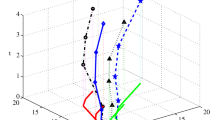Abstract
This paper proposes a method for grouping trajectories as two-dimensional time-series data. Our method employed a two-stage approach. Firstly, it compared two trajectories based on their structural similarity, and determines the best correspondence of partial trajectories. Then, it calculated the value-based dissimilarity for the all pairs of matched segments, and outputs their total sum as the dissimilarity of two trajectories. We evaluated this method on two data sets. Experimental results on the Australia sign language dataset and chronic hepatitis dataset demonstrate that our method could capture the structural similarity between trajectories even in the presence of noise and local differences, and could provide better proximity for discriminating objects.












Similar content being viewed by others
References
Babaud, J., Witkin, A. P., Baudin, M., & Duda, O. (1986). Uniqueness of the Gaussian kernel for scale-space filtering. IEEE Transactions PAMI, 8(1), 26–33.
Dudek, G., & Tostsos, J. K. (1997). Shape representation and recognition from multiscale curvature. Computer Vision and Image Understanding, 68(2), 170–189.
Everitt, B. S., Landau, S., & Leese, M. (2001). Cluster analysis (4th ed.). London: Arnold.
Keogh, E., & Pazzani, M. (2000). Scaling up dynamic time warping for datamining applications. In Proceedings of the sixth ACM SIGKDD international conference on knowledge discovery and data mining (pp. 285–289).
Lee, J-G., Han, J., & Whang, K.-Y. (2007). Trajectory clustering: A partition-and-group framework. In Proceedings of the 2007 ACM SIGMOD international conference on management of data (pp. 593–604).
Lindeberg, T. (1990). Scale-space for discrete signals. IEEE Transactions on Pattern Analysis and Machine Intelligence, 12(3), 234–254.
Lowe, D.G. (1980). Organization of smooth image curves at multiple scales. International Journal of Computer Vision, 3, 119–130.
Matsumura, H., Moriyama, M., Goto, I., Tanaka, N., Okubo, H., & Arakawa, Y. (2000). Natural course of progression of liver fibrosis in patients with chronic liver disease type c in Japan—A study of 527 patients at one establishment in Japan. Journal of Viral Hepatitis, 7, 375–381.
Mokhtarian, F., & Mackworth, A. K. (1986). Scale-based description and recognition of planar curves and two dimensional shapes. IEEE Transactions on Pattern Analysis and Machine Intelligence, PAMI-8(1), 24–43.
Pohl, A., Behling, C., Oliver, D., Kilani, M., Monson, P., & Hassanein, T. (2001). Serum aminotransferase levels and platelet counts as predictors of degree of fibrosis in chronic hepatitis c virus infection. American Journal of Gastroenterology, 96, 3142–3146.
Ueda, N., & Suzuki, S. (1990). A matching algorithm of deformed planar curves using multiscale convex/concave structures. IEICE Transactions on Information and Systems, J73-D-II(7), 992–1000.
Vlachos, M., Kollios, G., & Gunopulos, D. (2002). Discovering similar multidimensional trajectories. In Proceedings of the IEEE 18th international conference on data engineering (pp. 673–684).
Wang, X., Wirth, A., & Wang, L. (2007). Structure-based statistical features and multivariate time series clustering. In Proceedings of the 7th IEEE international conference on data mining (pp. 351–360).
Witkin, A. P. (1983). Scale-space filtering. In Proc. the eighth IJCAI (pp. 1019–1022).
Author information
Authors and Affiliations
Corresponding author
Rights and permissions
About this article
Cite this article
Tsumoto, S., Hirano, S. Detection of risk factors using trajectory mining. J Intell Inf Syst 36, 403–425 (2011). https://doi.org/10.1007/s10844-009-0114-7
Received:
Revised:
Accepted:
Published:
Issue Date:
DOI: https://doi.org/10.1007/s10844-009-0114-7




